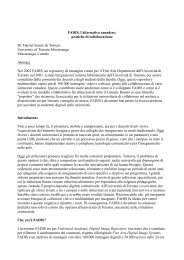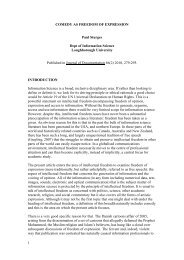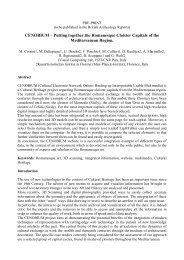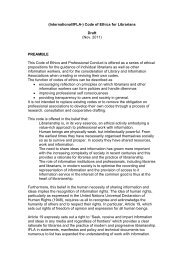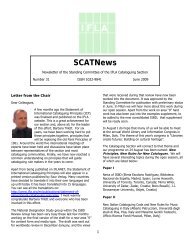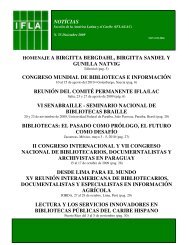No 49 - IFLA
No 49 - IFLA
No 49 - IFLA
You also want an ePaper? Increase the reach of your titles
YUMPU automatically turns print PDFs into web optimized ePapers that Google loves.
6<br />
International Preservation News <strong>No</strong>. <strong>49</strong> December 2009<br />
Emergency Preparedness and the Power of Partnerships<br />
by Jane S. Long<br />
Vice President, Emergency Programs, Heritage Preservation, Inc., Washington DC<br />
In August 2009, a two-alarm fire swept through the attic of<br />
the historic Ropes Mansion in Salem, Massachusetts. The<br />
19 th Century Georgian Colonial, owned by the Peabody Essex<br />
Museum, is notable because its fine collection of furnishings<br />
and decorative art belonged to the Ropes family. Virtually all<br />
of the valuable artifacts, family papers, and furnishings survived<br />
the blaze. The museum staff counted themselves lucky,<br />
but planning and cooperation made the real difference.<br />
The museum had a trained response team of conservation and<br />
curatorial staff who assembled quickly on the hot Saturday afternoon.<br />
The responding fire departments recognized the expertise<br />
of staff and the value of the historic structure and its contents.<br />
Firefighters not only allowed the staff to rescue the treasures on<br />
lower floors when it was safe, they also shifted and covered<br />
heavier objects that staff could not remove. They fought the fire<br />
with a minimum of water and did little damage to the top floor.<br />
A museum official described their response as “miraculous” 1 .<br />
Unfortunately, the many emergencies that strike cultural institutions<br />
rarely end so well. In the fall of 2005, an estimated<br />
70 museums and historical societies and more than 250 libraries<br />
in five states on the Gulf Coast of the United States suffered<br />
damage from Hurricanes Katrina, Rita, and Wilma. Even months<br />
later, some collections remained in peril from mold and neglect.<br />
Smaller incidents take their toll as well. A frozen waterline<br />
burst on the third floor of Montana State University’s Renne<br />
Library in Bozeman, Montana, in January 2008. Water flowed<br />
for nearly 30 minutes before emergency responders could<br />
shut off the fire suppression system, which released nearly<br />
1,800 gallons of water. The water damaged hundreds of the<br />
library’s most prized collections, including original signed and<br />
manuscript copies of books about Montana, Yellowstone<br />
National Park, and the famed Lewis and Clark expedition 2 .<br />
National Partnership for Cultural Heritage<br />
For fifteen years, Heritage Preservation, a national nonprofit<br />
in Washington, DC, has been working to bring about more<br />
frequent “happy endings” to the countless stories of fires,<br />
floods, and other disasters that threaten life and heritage. In<br />
late 1994, Heritage Preservation – along with the Federal<br />
Emergency Management Agency (FEMA), and the Getty<br />
1. Tom Dalton, “Ropes Mansion: a treasure saved”, The Salem News Online,<br />
August 18, 2009, http://salemnews.com/punews/local_story_230002502.html<br />
(Accessed <strong>No</strong>vember 25, 2009).<br />
2. Daniel Person, “Flood damages MSU library books”, Bozeman Daily<br />
Chronicle, January 23, 2008; Gail Schontzler, “MSU library leaks”, Bozeman<br />
Daily Chronicle, January 30, 2008; and Anne Pettinger, “Once damaged<br />
by flooding, dried books return to MSU library”, MSU News, March 19, 2008.<br />
www.montana.edu/cpa/news/nwview.php?article=5705 (accessed<br />
June 19, 2009).<br />
Conservation Institute (GCI) – convened the National Summit<br />
on Emergency Response.<br />
More than 80 representatives of regional and national organizations<br />
came together out of concern for the safety of America’s<br />
collections and historic places. Participants recognized<br />
that American libraries, museums, and historic sites were ill<br />
equipped to respond to emergencies in their own institutions<br />
or come to the aid of their neighbors.<br />
The gathering was significant for two reasons. First, it encouraged<br />
the library, archives, museum, and historic preservation<br />
communities to join forces around a single issue. Second, it<br />
marked a major public commitment by FEMA to help “reduce<br />
the future impact of natural disasters on our cultural and historic<br />
institutions across this nation” 3 . FEMA, now part of the<br />
U.S. Department of Homeland Security, coordinates the federal<br />
government’s role in preparation, prevention, mitigation,<br />
response, and recovery for domestic disasters.<br />
The creation of the Heritage Emergency National Task Force<br />
followed a few months later. The Task Force is a partnership<br />
of 41 national service organizations and federal agencies.<br />
Together its members constitute a nationwide resource of<br />
information, expertise, and assistance. Its mission is to:<br />
Help cultural heritage institutions and sites prepare for emergencies<br />
and obtain needed resources when disaster strikes.<br />
Encourage the incorporation of cultural and historic assets into disaster<br />
planning and mitigation efforts at all levels of government.<br />
Facilitate a more effective and coordinated response to all<br />
kinds of emergencies, including catastrophic events.<br />
Assist the public in recovering treasured heirlooms damaged<br />
by disasters.<br />
1. Heritage Preservation Logo.<br />
Heritage Preservation serves as the secretariat for the Task<br />
Force and as a clearinghouse of information during major<br />
regional disasters affecting cultural property. Since Hurricane<br />
Katrina, Task Force members have agreed upon a protocol that<br />
facilitates the sharing of damage reports, disseminates information<br />
resources, and links institutions affected by the disaster<br />
with available assistance for response and recovery. In addition<br />
to its coordinating role, Heritage Preservation has worked with<br />
other Task Force members to create a number of information<br />
tools to help libraries, archives, and museums prepare for and<br />
respond to emergencies.<br />
3. Former FEMA Administrator James L. Witt at the National Summit on<br />
Emergency Response in Washington, DC. December 1, 1994.



